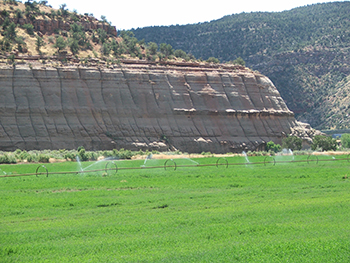Agricultural Water Optimization Task Force
The Agricultural Water Optimization Task Force was formed in 2018 to identify critical issues facing the state’s long-term water supply, to optimize agricultural water supply for future needs and to sustain Utah’s vital agriculture industry and heritage. The task force identified obstacles and constraints to optimization and recommended ways to improve the quantification of agricultural water use.
In 2023, the Utah Legislature passed SB 277, which appropriated $200 million for agricultural optimization and created a new committee housed within the Utah Department of Agriculture and Food.
This page archives the work completed by the task force over its lifespan from 2018-2023. This research helps the state evaluate ways to improve agricultural water use practices, create benefits for farmers, optimize water use and protect water quantity and quality for all uses in the system.

Contact:
Aaron Austin
Agricultural Water Optimization Task Force Admin Support
aaronaustin@utah.gov
Background
HB381 Agricultural Water Optimization
|
HB39 Agricultural Water Optimization Task Force Amendments |
Utah Department of Agriculture and Food (UDAF) Water Optimization Funding Program |
Research Plan for Agricultural Water Optimization in Utah
|
Research Needs
|
Annual Summaries
Ag Water Optimization Task Force Overview 2018-2023 (June 2023) This overview of the task force’s work from 2018-2023 was provided by the facilitator at the task force’s last meeting on June 9, 2023. |
Ag Water Optimization Task Force Annual Report (November 2022) This annual report gives an update on the UDAF Ag Water Optimization Funding and the ongoing projects funded by the task force. It includes recommendations for agricultural water optimization investments going forward and notes key obstacles. The additional documents included identify potential research studies and important policy questions to be answered. |
Ag Water Optimization Task Force Annual Report (November 2021) This annual report gives an update on the recent progress made by the task force and recommendations for agricultural water optimization studies and investments going forward. |
Ag Water Optimization Task Force Summary (June 2020)
|
Research Studies
Case Study: Validating Methods for Measuring Evapotranspiration and Accounting for Actual Depletion in Utah (June 2023)
|
Utah Agricultural Water Optimization – Water Savings from Drip Irrigation (December 2021)
|
Literature Review of Current & Upcoming Irrigation Technologies and Practices Applicable to Utah (November 2020)
|
Depletion Accounting for Irrigation Water Rights in Utah
|
Case Study of Emery County Agriculture Water Quantification System Implementation
|
Long-term Water Optimization Trials: Stacking Conservation Practices (2019 - ongoing) This is an ongoing study being completed by Utah State University with multiple partners to investigate how different combinations of crop genetics, crop types, tillage, emerging irrigation technologies and irrigation levels can both benefit agricultural production and reduce water consumption. |
